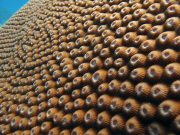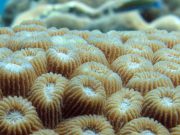Honeycomb Coral
(Diploastrea heliopora)
Honeycomb coral colonies are easy to distinguish from other coral species, and can grow to massive sizes, creating dense colonies several meters wide. Many coral species have some variation depending on depth, location, water clarity, etc., however this species has very little variation and is easy to identify.
Diploastrea heliopora @ Koh Haa
The large polyps live within corallites which are low, dome-shaped and closely packed, creating a honeycomb-like effect.
The corallite walls are thick, but not solid, rather they are formed of ridges which are the enlarged outer ends of the septa. The septa are equal and are thick at the wall and thin where joining the columellae (top/opening of the corallite).
Honeycomb coral @ Koh Bida
The coral surface appears smooth and can be cream, grey, light brown or green. This is a zooxanthellate species.


